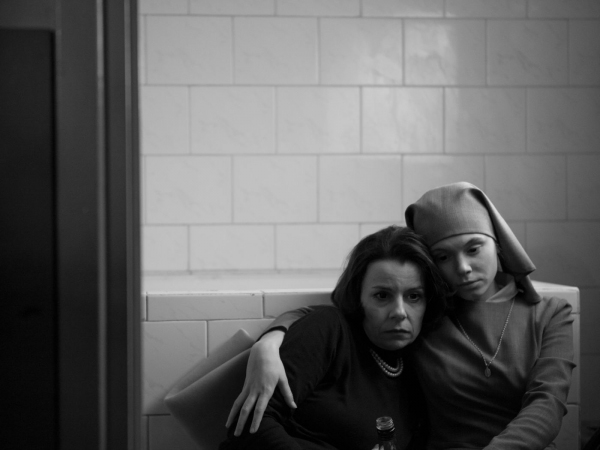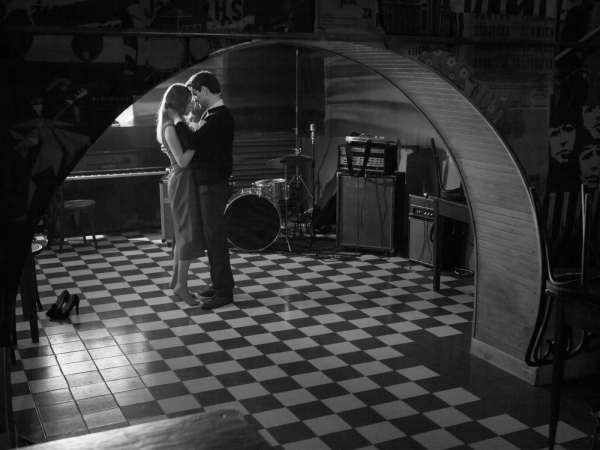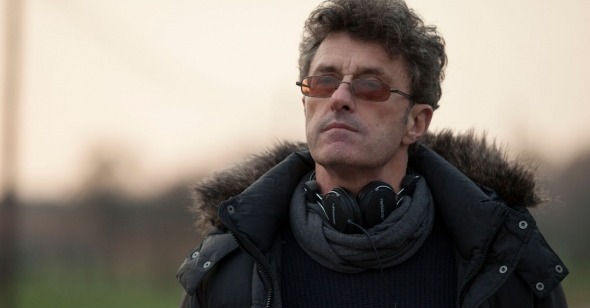Austere Nostalgia:
An Interview with Pawel Pawlikowski
by Eric Hynes
Ever since his acclaimed second theatrical feature, Last Resort, snuck its way into stateside art houses at the top of the millennium, itâs been futile to find a familiar box to place Pawel Pawlikowski in. The films of this Polish born, UK-based filmmaker can house bleeding hearts inside cool bodies, intimations of political purpose inside tightly focused psychological portraiture, and vice versa, and emotionally immediate performances inside works of formal austerity. Perhaps not coincidentally, his films tend to center on characters, usually women, who similarly arenât easily contained or pegged. In Ida, only his fourth feature in sixteen years, and his first shot in his native Poland, he revisits the early 1960s for the story of a young Polish nun-to-be named Anna (Agata Trzebuchowska), who discovers that sheâs actually a Jew named Ida and that sheâs her familyâs only Holocaust survivor, outside of a melancholic, communist justice Aunt named Wanda (Agata Kulesza). Despite the seemingly noncommercial use of static shots, long takes, black-and-white photography, an atypical 4:3 frame, and an elliptical narrative approach, Pawlikowski nevertheless pulled off one of the most widely celebrated films of 2014. Long before Ida was nominated for two Oscars (best foreign-language film and best cinematography) this year, the engaging director sat down with me at the 2013 Marrakech International Film Festival for a conversation about the filmâand storytelling, photography, religion, the glory of Polish women, and more.
Reverse Shot: Since youâve been living and working in England for a long time, encompassing your breakthrough, Last Resort, as well as My Summer of Love and The Woman in the Fifth, your previous film, what brought you back to your native Poland for Ida?
PP: Nostalgia. This is a period of my life when Iâm going back over things. After The Woman in the Fifth, which is a kind of strange solipsistic thing that happens in somebodyâs head, I just wanted to touch on something more concrete, something to do with history, something to do with my roots. I have a real nostalgia for that period, but not just nostalgiaâI find it really interesting. It was the early 1960s, when colonialism was rotting away after the heroic Stalinist period. When the war was fading away into memory. And rock ânâ roll was coming up, and there was a new vitality. I find it a cool period, and I wanted to convey that somehow.
RS: How old were you during that time?
PP: I was a kid. But I remember things very intensely. Everyone does when they see things for the first time. I was born in â57, so I was five, six, or seven.
RS: So you romanticize it to some degree?
PP: Definitely. But at the same time itâs more of an unfiltered, vivid memory of things. When you see things as an adult, you interpret them. Whereas as a kid, you could really just absorb themâand that marks you for life. The sounds of these pop songs, I remember them more vividly than songs I heard ten years agoâI remember all the lyrics, like all kids do. The fascination with carsâthere were not many cars around, but the car thatâs in the film is a car I was obsessed with. And then the provincial hotel, the bandâa lot of it is kind of idealized. Though people find the film depressing, so I guess itâs not exactly idealized. But for me, itâs a kind of recovery of a memory.
RS: How personal is Idaâs story?
PP: Itâs very diluted, the reasons for doing it. It was three or four things coinciding. I wouldnât have made a film about just one subjectâabout a personal memory or about politics or history. Putting together the characters of Wanda and Ida, and the landscape, and the pop music, and the rotting socialismâsuddenly it all became an interesting soup. Which is the way I think. People say: what is this film about? Well itâs many things. Thereâs no one thing. And I donât like films that are about one thing. Wanda is partly based on somebody I met, but sheâs also my own creation. I was also interested in the idea of religion, and of how people define religion. Because Poland, well, itâs Catholic by definition. And this Pola Catholic is so limiting. In terms of what it means to be a Pole, because before the war only 60% were Catholicsâthere were Lithuanian Protestants, Ukrainian Uniates, and Jews, a lot of Jews. It was a much more complex, interesting society. But itâs also limiting to religion, for it to be defined as some kind of tribal marking rather than a transcendental, universal faith. Which is what Jesus was representing. In Poland it became something that defined us in opposition to the Protestant Prussians, to the Orthodox and Communist Russians. And itâs totally limiting. So in the figure of Ida, who discovers that she has Jewish blood, and yet doesnât lose her faithâher identity shifts a littleâI wanted to explore that and stir things up a bit. And I did stir things up a bit. It is quite a controversial film in Poland.
RS: How so?
PP: Most people like itâthe reviews were brilliant. But on the nationalist side, the extremists, people say, âHow could you show Poland in such a bad light?â And then some Jewish people say, âWhy did you show that Wanda has blood on her hands, that sheâs a Stalinist politico?â Thatâs a bit rich, because of course there were quite a few active communists of Jewish origins. Not exclusivelyâbut a high percentage, for various historical reasons, and thereâs nothing wrong with that. So I stepped onto a minefield of stuff. Thereâs a kind of debate raging that has nothing to do with cinema, nothing to do with art, nothing to do with humanity. Itâs more to do with a big football game going on, and this film became a ball in that never-ending game for a while. But itâs such an opaque film, and itâs so multilayered, that sooner or later all these accusations fall away and seem a bit absurd. Because the film has its own kind of internal rules, and the characters are very specific, and dense, and theyâre not there to represent ideas about Poles or Jews or anything. Theyâre just very rich, or I hope so.
RS: Itâs telling to me that you used the word opaque. Itâs certainly not your standard âbring the past to lifeâ historical narrative.
PP: I tried to steer away from explaining history. Very often when you make a film about history, a lot of the dialogue, or scenes even, are devoted to explaining to audiences that havenât got a clue about history. And I didnât want to do that. This is the historical moment, these are the characters, a lot is touched upon, and if you make sense of it, great, and if you donât make sense of it, it still kind of works in a universal way. Iâm not going to try to explain, because thereâs no one explanation of history anyway, and itâs not the job of cinema to explain. Cinema is some kind of magical exercise that creates a world and draws the audience in, and they have to experience something emotionally, rather than something for journalists to discuss. Iâm not making it to be a discussion piece.
RS: You also chose a period of time thatâs not easily explained or summarized. You have people actively trying to bury the past, trying to move on from something that happened fifteen years prior. In some ways thatâs still going on fifty years later, but in this particular moment war was, as you say, fading into memory, yet there were plenty of people around whose entire lives were destroyed or affected by it.
PP: Yet there was a lot of optimism in that time. Even in the 1950s, during the Stalinist Terror, there was some kind of faith that things would get better. And in the 1960s too, with pop music and jazz. You canât repress human vitality or exuberance for long. It always comes out whenever you leave cracks open. That time was a kind of brink between two eras.
RS: So much of the film seems to be about balanceâbetween those two eras, between the two female leads, between life and death, even between the upper and lower halves of the frame.
PP: Itâs a kind of tightrope thing. The aunt character is so strong, but underneath, all the time, is the journey of Ida. It was difficult to balance these two things so that it wouldnât be completely thrown off kilter. Then I imposed formal constraints on the whole thing. I tried to make things as strong as possibleâfor each scene to be a thing in itself rather than leading to something.
RS: Thereâs a great economy to it. Each scene is indeed self-contained and strong, and also often staggeringly beautiful. But you move things forward from scene to scene rather rapidly. Youâre not dwelling too long in any place.
PP: Iâm really bored with storytellingâwith normal storytelling, I should say. Where things are explained and led to. Iâm more into a poetic shorthand, where itâs simple enough for you to make sense of, but Iâm not going to bloody guide you from scene to scene. In making this film I realized that itâs going to leave a lot of people cold. I donât try to seduce the audience too much, so you know youâre going to lose a lot of them. But those who stay might benefit, or like it more.
RS: Visually itâs hard to look away from.
PP: Well that helps.
RS: Why did you shoot in the boxy academy ratio instead of widescreen?
PP: Partly it was the period idea I had. I remember seeing films in that ratio during that time. And it had something to do with my family photo albums of that time. Also it was an attempt to not show too much, to not show whatâs around too much. To limit the field of vision, and make the most of a few elements in the shot. There was a general tendency also to not move the camera. To suggest as much as possible by showing as little as possible. Also in terms of narrativeâthis elliptical moving from place to place. I donât show some events, and you have to work out what happens in the absence. Also 4:3 is really good for portraits and double-portraits. I knew it would be a lot of these two womenâs faces.

RS: Yet thereâs still so much negative space. It not being widescreen, youâd think there would be less of it. In particular, thereâs a lot of height.
PP: I kind of pushed it that way. At some point, in some wider shots, the two bodies were blocking the picture, so I just intuitively asked my cameraman to tilt the camera up, just to see what happens. And suddenly they looked very touching, these two torsos lost in space. They looked kind of vulnerable. And the sky became important. There was no intellectual design, but it felt really good somehow. Looking back I can see what it could mean, but it just felt good and I stuck to this thing for a while, especially for the wider shots. And then it became a kind of method for the whole film.
RS: Thereâs also that moment when Ida is crying, and you actually bisect her face.
PP: When sheâs in hospital and dips down? Itâs quite dramatic. It would have been really banal to tilt down with her. Thereâs something more hieratic about not doing that. Also thereâs some kind of objective force that tells the story. Itâs not them. Hopefully you still sympathize with them but youâre not with them. Also I felt from the very beginning that photography was one of the protagonists of this film. I wanted it to be a photographic film. To tell each scene in a good shot. To find the ideal angle, ideal framing, and then not have to do coverage. Which is difficult for actors. There were a lot of takes to get it right. But it does give it a kind of intensity. You can make sure that each image carries, that itâs not functional, that the image is as important as what happens, as important as the performance of the actors. It was difficult in practice. Because usually you follow the actors and itâs handheldâor you shoot it for images and the actors have to suffer, and play fake sometimes because itâs all for the picture. To try to get both things to work at the same time, and at the same level of expressiveness, is very difficult. If you donât cut, you canât cheat very much with the performance. It has to be really good or believableâthereâs no safety net. There was no coverage for any of these scenes. More or less what you see is what was shot.
RS: Does that intensify your relationship with the actors?
PP: Yeah, I mean they really have to trust you. Actors get pissed off when they feel that itâs done for the image. Here they knew what I was trying to do, and theyâre great people. No narcissism at all. We were like one body, the whole film crew. And I had a great young DP, whoâd never shot a film before. He took over from the original one who dropped out on the first day. He was just a camera operator on our film, and I couldnât find anybody else so we just upgraded him to be our DP. And he came up trumps.
RS: But I imagine thatâs a lot to do with youâyou knew what you wanted.
PP: But he was really open-minded. He had a great deal of youthful energy, and no reputation to worry about. Because some of the framing was so bonkers. [Laughs] A lot of old DPs who saw the film in Poland were really pissed off about it. Like, the framing is so off. But he was like, great, letâs do it like this. And he was very sensitive with the lightâIâd work with him on my next film for sure. But it was an accident. Iâd never seen any of his work, he just happened to be there on the spot.
RS: Most of your films have centered on women. Are you consciously drawn to womenâs stories more than menâs?
PP: Not consciously to womenâs storiesâit just seems to work out that way. But of course Iâm consciously interested in women. And I find them more interesting than men. I like to get into their heads, and I think I can. At the same time theyâre sufficiently mysterious for me to want to get into their heads. As opposed to men, whom I can more or less project myself into and itâs not very interesting. I find women a known unknown. And women are more interesting humans anyway. Men have lost their way. [Laughs] Also in Eastern Europe and in Poland, the women are quite strong, theyâre all sorts of things. Theyâre feminine and heroic and protagonists of their own stories. I guess I just meet a lot of strong Polish women. Have you met [Polish director] Agnieszka Holland?
RS: No, I havenât.
PP: Sheâs very strong. Wanda is that, but she also wants to be a girl tooâto dance, and to fuck, and sheâs conflicted. There are a lot of things pulling her in different directions. Thatâs why I can identify with her. But sheâs more extremely conflicted than most.

